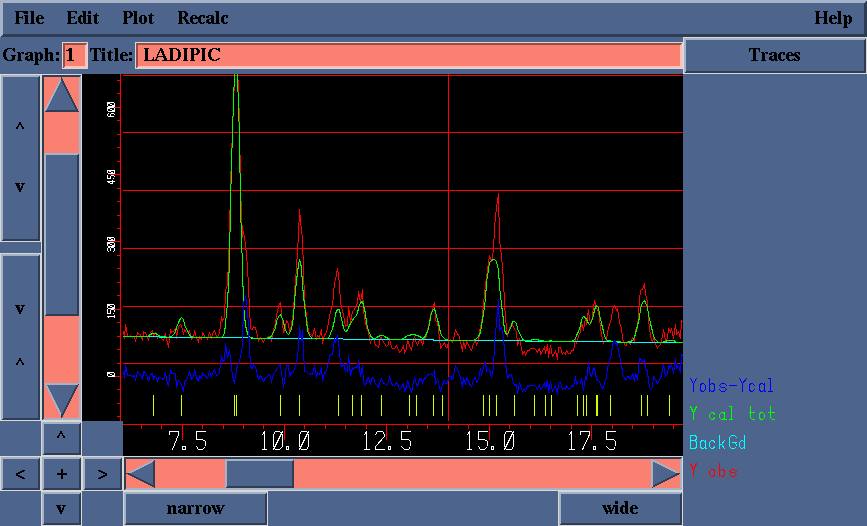4.48. POWGEN: Powder pattern graphics
Authors: Doug du Boulay
Contact: Doug du Boulay, Crystallography Centre, University of Western Australia, Nedlands 6907, Australia
Warning: This is alpha software!
POWGEN optionally reads a binary pattern archive created with ADDPAT and calculates the expected pattern. These patterns can be viewed and specific factors controlling the calculation manually adjusted to improve fit. The plot range and various graphics rendering attributes can be adjusted and the plots dumped to a plot file for editing or printing. Multiple plots can be generated on one page and multiple pages can be printed.
4.48.1. Overview
POWGEN is a graphical interface program for displaying and manipulating powder diffraction pattern plots. It was designed to permit the user to dump an image of the manipulated page to a .ppp file for previewing with PREVUE or plotting with PLOTX. Multiple pages can be dumped and multiple powder plots can be displayed on one page. The graphical interface was designed exclusively using Tcl/Tk graphics functions, but if desired, the on screen graphics mode can be turned off and a complete description of ONE single page can be specified from the POWGEN control lines. That allows for efficient plotting once a plot format has been designed. In interactive mode the user can manipulate many of the attributes of either, the current graph block, or the layout of the whole page.
POWGEN requires as input, either of a .pat file produced by ADDPAT, or a .POT file produced by RIETVD. A check is made for the .POT file first, defaulting to the .PAT file if it exists. If the .PAT file is obtained, it is envisaged that a powder profile could be calculated and manipulated to a certain extent on screen. That requires atom site and hkl data on the input bdf so ADDATM and ADDREF are prerequisites in this mode. Many of the RIETVD commands also apply to POWGEN.
Page layouts can be either rigorously enforced to users specifications, or optimised to fit the page in a number of ways. The page layout is specified via the ARANGE option, where relative graph block positions are specified on a 9x9 grid, with (5,5) defining the location of a one graph block page. Typically EXAMPP will initiate with one graph invoked but with others being added or deleted as the user requires.
4.48.2. File Assignments
Reads atom site and hkl data from the input archive file(s).
Reads measured powder pattern intensities from file PAT.
Reads calculated powder pattern intensities from file POT.
Writes powder pattern plot data to file PPP.
Writes card images to punch file PCH (not implemented yet).
4.48.3. Examples
POWGEN pat ho cm 0.5 1.0 : phase ed 0.00065 : set the scale factor for this phase peak voight 10. 0.5 : span(in halfwidths) mixing func hwidth 0.008 0.01 0.0 : pasymm 0.0 0.0 : assume symmetric peak : block $2 5 5 : This block is centered in layout (5 5) : this block has no numeric label : So apply these settings to all subsequent blocks axis x 10 72 axis y -1000 10000 trace obs 1 0.0 0.10 1.0 no $2 1 trace cal 2 0.0 0.05 1.0 no $2 1 trace del 3 0.0 0.0 1.0 no $2 1 : block 2 5 6 : This graph block is below previous block titext This is graph number 2 axis x 10 30 : plot range 2 theta = 10 to 30 degrees axis y -1000 6000 : Intensity range axslab x two theta angle axslab y Intensity (counts per sec) trace obs 1 0.0 0.1 1.0 no $2 1 : plot observed trace cal 2 0.0 0.0 1.0 no $2 1 : plot calculated trace del 3 0.0 0.2 1.0 no $2 1 : plot difference (delta) : : If print is requested a .ppp plot file is written PREVUE ppp PLOTX xfigl ppp : produce .fig file for line editing/printing in XFIG finish |
